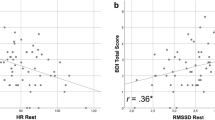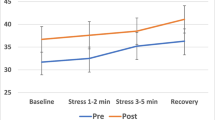Abstract
This study examines cardiovascular recovery from mental stress. Investigating the absence or presence of carryover effect, the effect of the final reactivity observed at the end of stressful task on the successive recovery, was the major objective. A recently advocated recovery measure related to the area under the curve, mean recovery rate (MRR), was investigated, comparing with the two relatives of this type, total carryover (TCO) and literally area under the curve (AUC). At the onset, a detailed theoretical formulation of each measure was carried out, starting from its original definition. It was predicted that MRR, but not TCO or AUC, could be free from the carryover effect. Next, 88 male students underwent a 5-min mental arithmetic during which blood pressure and heart rate were measured. Nearly all the theoretical predictions (i.e., 5/6 for the three recovery measures by two cardiovascular parameters) were supported by experimental data. There was only one exception: for heart rate, there was a proportional relationship even for MRR versus the final reactivity. Vagal rebound in the recovery period was conceived as the main contributor of this contradiction. The implications of these results for the understanding of future directions in recovery studies are discussed.


Similar content being viewed by others
References
Allen MT, Sherwood A, Obrist PA (1986) Interactions of respiratory and cardiovascular adjustments to behavioral stressors. Psychophysiology 23:532–541
Anderson EC, Mahoney LT, Lauer RM, Clarke WR (1987) Enhanced forearm blood flow during mental stress in children of hypertensive parents. Hypertension 10:544–549
Anderson JC, Linden W, Habra ME (2005) The importance of examining blood pressure reactivity and recovery in anger provocation research. Int J Psychophysiol 57:159–163
Christenfeld N, Glynn LM, Gerin W (2000) On the reliable assessment of cardiovascular recovery: An application of curve-fitting techniques. Psychophysiology 37:543–550
Cole CR, Blackstone EH, Pashkow FJ, Snader CE, Lauer MS (1999) Heart-rate recovery immediately after exercise as a predictor of mortality. N Engl J Med 341:1351–1357
Earle TL, Linden W, Weinberg J (1999) Differential effects of harassment on cardiovascular and salivary cortisol stress reactivity and recovery in women and men. J Psychosom Res 46:125–141
Evans GW, Kim P, Ting AH, Tesher HB, Shannis D (2007) Cumulative risk, maternal responsiveness, and allostatic load among young adolescents. Dev Psychol 43:341–351
Gerin W, Davidson KW, Christenfeld N, Goyal T, Schwartz JE (2006) The role of angry rumination and distraction in blood pressure recovery from emotional arousal. Psychosom Med 68:64–72
Gerin W, Pieper C, Marchese L, Pickering TG (1992) The multi-dimensional nature of active coping: differential effects of effort and enhanced control on cardiovascular reactivity. Psychosom Med 54:707–719
Goedhart AD, van der Sluis S, Houtveen JH, Willemsen G, de Geus EJC (2007) Comparison of time and frequency domain measures of RSA in ambulatory recordings. Psychophysiology 44:203–215
Gump BB, Mathews KA (1999) Do background stressors influence reactivity to and recovery from acute stressors? J Appl Soc Psychol 29:469–494
Jennings JR, Kamarck R, Stewart C, Eddy M, Johnson P (1992) Alternative cardiovascular baseline assessment techniques: vanilla or resting baseline. Psychophysiology 29:742–750
Julius S (1988) The blood pressure seeking properties of the central nervous system. J Hypertens 6:177–185
Kario K, Schwartz JE, Gerin W, Robayo N, Maceo E, Pickering TG (2002) Psychological and physical stress-induced cardiovascular reactivity and diurnal blood pressure variation in women with different work shifts. Hypertens Res 25:543–551
Linden W, Earle TL, Gerin W, Christenfeld N (1997) Physiological stress reactivity and recovery: conceptual siblings separated at birth? J Psychosom Res 42:117–135
Linden W, McEachern HM (1985) A review of physiological prestress adaptation: effects of duration and context. Int J Psychophysiol 3:67–74
Llabre MM, Spitzer SB, Saab PG, Ironson GH, Schneiderman N (1991) The reliability and specificity of delta versus residualized change as measures of cardiovascular reactivity to behavioral challenges. Psychophysiology 28:701–711
Lovallo WR (2005) Cardiovascular reactivity: mechanisms and pathways to cardiovascular disease. Int J Psychophysiol 58:119–132
Mezzacappa ES, Kelsey RM, Katkin ES, Sloan RP (2001) Vagal rebound and recovery from psychological stress. Psychosom Med 63:650–657
Myrtek M, Spital S (1986) Psychophysiological response patterns to single, double, and triple stressors. Psychophysiology 23:663–671
Pickering TG, Hall JE, Appel LJ, Falkner BE, Graves J, Hill MN, Jones DW, Kurtz T, Sheps SG, Roccella EJ (2005) Recommendations for blood pressure measurement in humans and experimental animals Part 1: blood pressure measurement in humans. A statement for professionals from the Subcommittee of Professional and Public Education of the American Heart Association Council on High Blood Pressure Research. Circulation 111:697–716
Piferi RL, Kline KA, Younger J, Lawler KA (2000) An alternative approach for achieving cardiovascular baseline: viewing an aquatic video. Int J Psychophysiol 37:207–217
Pruessner JC, Kirschbaum C, Meinlschmid G, Hellhammer DH (2003) Two formulas for computation of the area under the curve represent measures of total hormone concentration versus time-dependent change. Psychoneuroendocrinology 28:916–931
Salomon K, Clift A, Karlsdottir M, Rottenberg J (2009) Major depressive disorder is associated with attenuated cardiovascular reactivity and impaired recovery among those free of cardiovascular disease. Health Psychol 28:157–165
Sarlo M, Buodo G, Munafo M, Stegagno L, Palomba D (2008) Cardiovascular dynamics in blood phobia: evidence for a key role of sympathetic activity in vulnerability to syncope. Psychophysiology 45:1038–1045
Sawada Y (1993) Reproducible increases in blood pressure during intermittent noise exposure: underlying haemodynamic mechanisms specific to passive coping. Eur J Appl Physiol Occup Physiol 67:367–374
Sawada Y, Kato Y (2009) Mean recovery rate: a simple measure of recovery uncontaminated by the carryover effect. Jpn Psychol Res 51:274–278
Sawada Y, Nagano Y, Tanaka G (2002) Mirror tracing and the provocation of vascular-dominant reaction pattern through heightened attention. J Psychophysiol 16:201–210
Schuler JL, O’Brien WH (1997) Cardiovascular recovery from stress and hypertension risk factors: a meta-analytic review. Psychophysiology 34:649–659
Sherwood A, Dolan CA, Light KC (1990) Hemodynamics of blood pressure responses during active and passive coping. Psychophysiology 27:656–668
Acknowledgments
This study was supported in part by the Grant-in-Aid for Young Scientists (B) from Japan Society for the Promotion of Science (Grant no. 21700697).
Author information
Authors and Affiliations
Corresponding author
Rights and permissions
About this article
Cite this article
Sawada, Y., Kato, Y. How carryover has an effect on recovery measures related to the area under the curve: theoretical and experimental investigations using cardiovascular parameters. Med Biol Eng Comput 49, 297–304 (2011). https://doi.org/10.1007/s11517-011-0744-0
Received:
Accepted:
Published:
Issue Date:
DOI: https://doi.org/10.1007/s11517-011-0744-0




